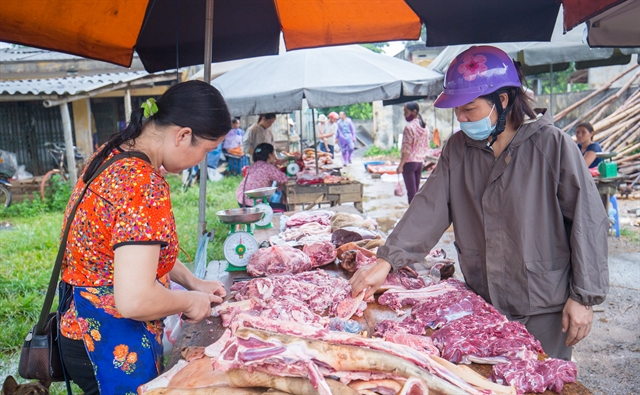 Opinion
Opinion

 |
| A traditional market of ethnic people in Đà Bắc District, northern Hòa Bình Province. Washing surfaces, equipment and vendors’ hands are recommended to ensure good hygienic practices at traditional markets. — Photo courtesy of ILRI |
On the occasion of World Food Safety Day (June 7), Việt Nam News reporter Khánh Dương spoke to Dr Fred Unger, a senior scientist and regional representative of International Livestock Research Institute (ILRI) East and Southeast Asia, a CGIAR centre, about ensuring food safety along the pork value chain from the farm to the dining table.
Could you share with us some of the food safety challenges in the pork value chain in Việt Nam?
Pork is the most consumed meat in Việt Nam and Salmonella contamination is high. One to two in 10 people are at risk of Salmonellosis annually.
Salmonella is often contracted through the consumption of contaminated food or water. Foods at the highest risk of contamination are those of animal origin, but fruit and vegetables can also transmit the disease.
In Việt Nam, bacteria are one of the most common causes of food poisoning, such as E. coli, Salmonella, Campylobacter, Clostridium, Staphylococcus. Symptoms of bacterial food poisoning usually appear 12-72 hours or more after eating contaminated food. Common foodborne disease symptoms are diarrhoea and vomiting, typically lasting one to seven days. Other symptoms might include abdominal cramps, nausea, fever and fatigue.
ILRI and its partners, the Hanoi University of Public Health, Vietnam National University of Agriculture, National Institute of Animal Sciences and University of Sydney have been working on food safety in traditional markets in Việt Nam for more than a decade and seek to reduce the burden of foodborne diseases.
Our recent project ‘Market-based approaches to improving pork safety in Việt Nam’ (SafePORK), co-funded by the Australian Centre for International Agricultural Research (ACIAR), CGIAR Research Programme on Agriculture for Nutrition and Health (A4NH) and CGIAR Initiative on One Health, developed approaches to improve food safety while safeguarding pork sector livelihoods. SafePORK shows that simple hygienic practices can considerably improve the safety of pork. Everyone can apply these hygienic practices to have safer pork for their daily meal.
What are key findings of the SafePORK project?
The team conducted surveys with traditional pork value chain actors.
Key causes of unsafe pork include poor hygiene, improper preservation and processing techniques, long transportation duration, disease, unclear origin of pork and low-quality inputs.
The research team introduced good hygienic practices at traditional slaughterhouses and traditional markets, as these places were identified as critical points of biological contamination.
The practices include separating ready-to-eat pork, raw or uncooked pork and intestines, and frequently washing surfaces, equipment, and vendors’ hands. At the slaughterhouse, workers were encouraged to use stainless-steel grids to prevent carcases from contacting the floor and better separation of clean and dirty zones to further reduce carcass contamination.
The simple interventions at surveyed traditional pork shops and slaughterhouses proved their effectiveness in reducing microbial contamination in pork. The prevalence of Salmonella decreased from 52 per cent to 24 per cent.
What should consumers do to better protect themselves from foodborne diseases? What is the most important factor in ensuring food hygiene and preventing foodborne diseases in households?
We promoted guidelines for consumers on five ways to safely preserve fresh meat in a refrigerator and defreeze pork, and introduced 10 golden rules in processing and preserving pork at home.
Washing hands, utensils, and kitchen surfaces often when cooking, especially while handling raw meats helps to prevent bacterial cross contamination at home.
Other rules are to keep fresh fruit and vegetables, raw meats, seafood, and eggs all separated during storage and meal preparation. Use separate utensils, cutting boards and plates for raw meats and vegetables.
 |
| Customers are advised to use separate utensils, cutting boards and plates for raw meats and vegetables. — VNS Photo Khánh Dương |
Cook food to its proper internal temperature to kill germs that may be present. Use a food thermometer to check internal temperature. Refrigerate perishable foods and leftovers within two hours to prevent new bacteria from growing.
These simple at-home interventions can help consumers prevent contracting foodborne diseases. Preventing foodborne illness is necessary at every stage of the pork value chain, from the farmers raising the animals to the end consumers.
What is your call to action on World Food Safety Day?
To promote food safety along the pork value chain and to protect human health from biological contamination, we call on our food safety authorities to heed the call of food safety researchers by immediately beginning to take steps to further reduce the biological contamination risks along the pork value chain.
We call on our leaders to support, adopt and promote good hygienic practices to pork shops at traditional markets and slaughterhouses.
As food safety is a shared responsibility involving the whole supply chain, from producers to consumers, we urge all actors in the pork value chains from farm to fork to take up low-cost investments to improve hygiene conditions at the slaughterhouse, traditional markets and households.
Action taken now can and will help reduce biological contamination as most foodborne disease is preventable with proper food handling and education at all levels, protecting the health of everyone. We cannot wait any longer. — VNS
Several ways to celebrate World Food Safety DayHÀ NỘI — The theme of World Food Safety Day (June 07, 2023) is “Food standards save lives”. It delivers the message of “Food safety is everyone’s business. No matter who you are or what you do, you play an important role in making sure food is safe to eat.”The World Health Organization and UN Food and Agriculture Organisation suggest several ways to celebrate World Food Safety Day with people around you. You can make a video about a farmer, health professional, chef or food business operator. Sharing experiences can help people understand just how important food safety is.Another way to celebrate is to test your knowledge. There are numerous ways you can learn about food safety or share your knowledge either in person or online.People are also encouraged to invite those who grow, process, sell or cook food to talk about or demonstrate what they do and why food safety is important to show good practices. — VNS
ILRI action for the World Food Safety Day 2023ILRI developed a landing page for World Food Safety Day 2023 with important information on food safety research for low and middle income countries including Việt Nam.ILRI co-hosts with the World Bank to launch a synthesis report on future actions for food safety for low and middle income countries.




